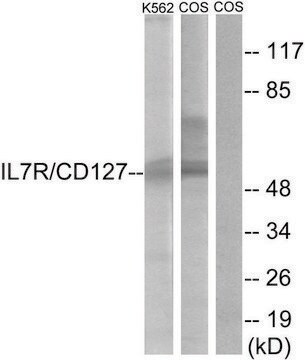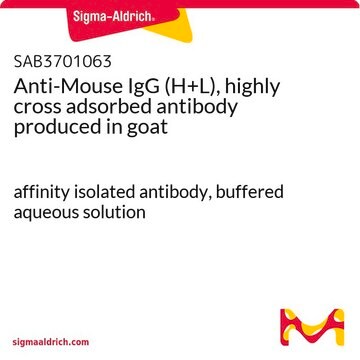SAB4600116
Monoclonal Anti-GFP IgG (H+L), CF™ 594 antibody produced in mouse
~2 mg/mL, clone 9F9.F9, purified immunoglobulin
About This Item
Produits recommandés
Source biologique
mouse
Conjugué
CF™ 594 conjugate
Forme d'anticorps
purified immunoglobulin
Type de produit anticorps
primary antibodies
Clone
9F9.F9, monoclonal
Forme
buffered aqueous solution
Concentration
~2 mg/mL
Technique(s)
indirect immunofluorescence: 1-10 μg/mL
Isotype
IgG1κ
Fluorescence
λex 593 nm; λem 614 nm
Conditions d'expédition
dry ice
Température de stockage
−20°C
Modification post-traductionnelle de la cible
unmodified
Catégories apparentées
Description générale
CF™ 594 is a deep red fluorescent dye with molecular weight ~730. CF™ 594 is highly water soluble and photostable, therefore, it is considered to have a potential application in confocal microscopy and single molecule imaging. CF™ 594 is particularly useful in combination with blue fluorescent CF™ 350, green fluorescent CF™ 488A and far red CF™ 640R for multi-color imaging. CF™ 594 has excitation laser line at 532nm, 568nm or 594nm and absorption/emission maxima at 593/614nm.
Green fluorescent protein (GFP) is highly visible and efficiently emitting internal fluorophore. These key features of GFP have made it a potential marker of gene expression and protein targeting in intact cells and organisms.
Spécificité
Immunogène
Caractéristiques et avantages
Forme physique
Notes préparatoires
Informations légales
Clause de non-responsabilité
Not finding the right product?
Try our Outil de sélection de produits.
Code de la classe de stockage
10 - Combustible liquids
Classe de danger pour l'eau (WGK)
WGK 2
Point d'éclair (°F)
Not applicable
Point d'éclair (°C)
Not applicable
Certificats d'analyse (COA)
Recherchez un Certificats d'analyse (COA) en saisissant le numéro de lot du produit. Les numéros de lot figurent sur l'étiquette du produit après les mots "Lot" ou "Batch".
Déjà en possession de ce produit ?
Retrouvez la documentation relative aux produits que vous avez récemment achetés dans la Bibliothèque de documents.
Les clients ont également consulté
Notre équipe de scientifiques dispose d'une expérience dans tous les secteurs de la recherche, notamment en sciences de la vie, science des matériaux, synthèse chimique, chromatographie, analyse et dans de nombreux autres domaines..
Contacter notre Service technique







